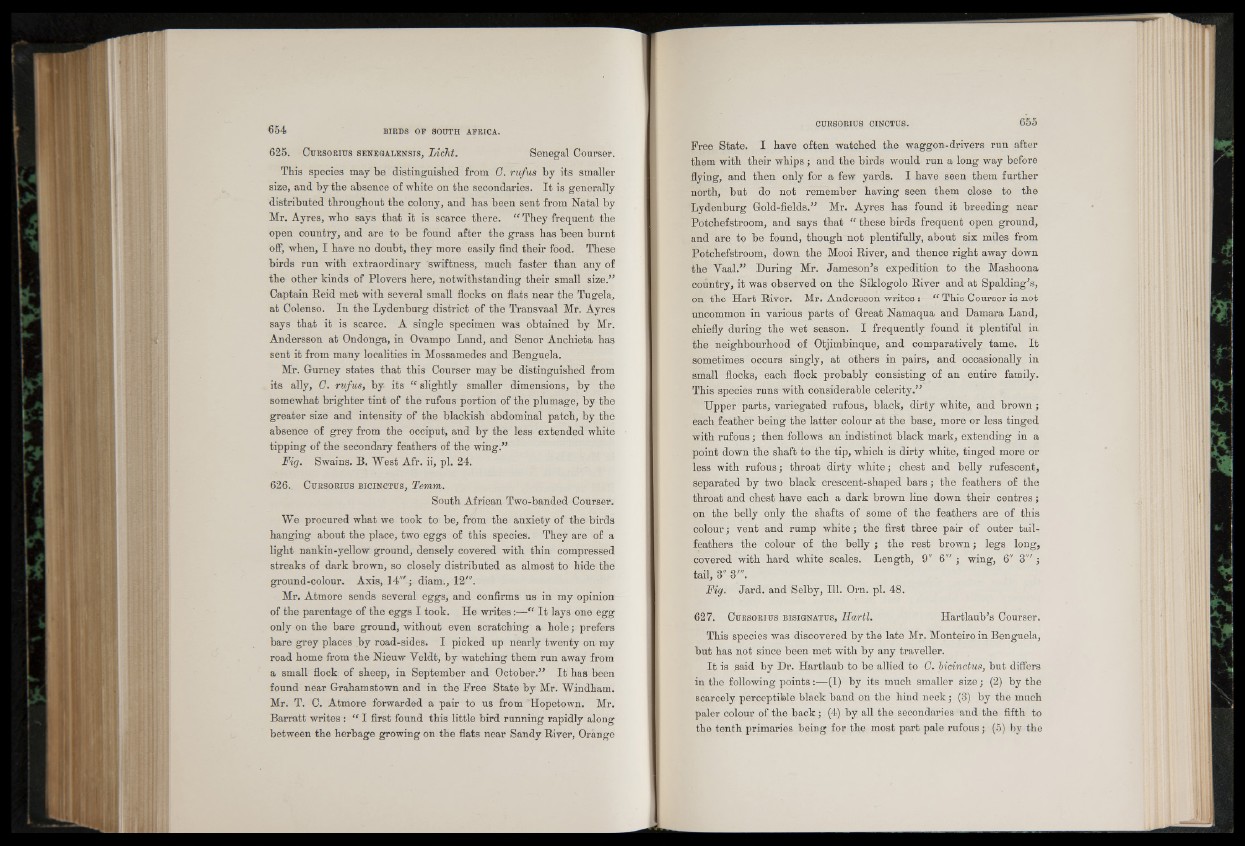
625. C ursorius senegalensts, Licht. Senegal Courser.
This species may be distinguished from 0. rufus by its smaller
size, and by the absence of white on the secondaries. It is generally
distributed throughout the colony, and has been sent from Natal by
Mr. Ayres, who says that it is scarce there. “ They frequent the
open country, and are to be found after the grass has been burnt
off, when, I have no doubt, they more easily find their food. These
birds run with extraordinary 'swiftness, much faster than any of
the other kinds of Plovers here, notwithstanding their small size.”
Captain Reid met with several small flocks on flats near the Tugela,
at Colenso. In the Lydenburg district of the Transvaal Mr. Ayres
says that it is scarce. A single specimen was obtained by Mr.
Andersson at Ondonga, in Ovampo Land, and Senor Anchieta has
sent it from many localities in Mossamedes and Benguela.
Mr. Gurney states that this Courser may be distinguished from
its ally, 0. rufus, by its “ slightly smaller dimensions, by the
somewhat brighter tint of the rufous portion of the plumage, by the
greater size and intensity of the blackish abdominal patch, by the
absence of grey from the occiput, and by the less extended white
tipping of the secondary feathers of the wing.”
Fig. Swains. B. West Afr. ii, pi. 24.
626.. C urso r iu s b ic in c tu s , Temm.
South African Two-banded Courser.
We procured what we took to be, from the anxiety of the birds
hanging about the place, two eggs of this species. They are of a
light nankin-yellow ground, densely covered with thin compressed
streaks of dark brown, so closely distributed as almost to hide the
ground-colour. Axis, 14'"-; diam., 12"'.
Mr. Atmore sends several eggs, and confirms us in my opinion
of the parentage of the eggs I took. He writes:—“ I t lays one egg
only on the bare ground, without even scratching a hole; prefers
bare grey places by road-sides. I picked up nearly twenty on ray
road home from the Nieuw Yeldt, by watching them run away from
a small flock of sheep, in September and October.” It has been
found near Grahamstown and in the Free State by Mr. Windham.
Mr. T. C. Atmore forwarded a pair to us from Hopetown. Mr.
Barratt writes : “ I first found this little bird running rapidly along
between the herbage growing on the flats near Sandy River, Orange
Free State. I have often watched the waggon-drivers run after
them with their whips ; and the birds would run a long way before
flying, and then only for a few yards. I have seen them further
north, but do not remember having seen them close to the
Lydenburg Gold-fields.” Mr. Ayres has found it breeding near
Potchefstroom, and says that “ these birds frequent open ground,
and are to be found, though not plentifully, about six miles from
Potchefstroom, down the Mooi River, and thence right away down
the Vaal.” During Mr. Jameson's expedition to the Mashoona
country, it was observed on the Siklogolo River and at Spalding's,
on the Hart River. Mr. Andersson writes :—“ This Courser is not
uncommon in various parts of Great Namaqua and Damara Land,
chiefly during the wet season. I frequently found it plentiful in
the neighbourhood of Otjimbinque, and comparatively tame. It
sometimes occurs singly, at others in pairs, and occasionally in
small flocks, each flock probably consisting of an entire family.
This species runs with considerable celerity.''
Upper parts, variegated rufous, black, dirty white, and brown;
each feather being the latter colour at the base, more or less tinged
with rufous; then follows an indistinct black mark, extending in a
point down the shaft to the tip, which is dirty white, tinged more or
less with rufous; throat dirty white; chest and belly rufescent,
separated by two black crescent-shaped bars; the feathers of the
throat and chest have each a dark brown line down their centres;
on the belly only the shafts of some of the feathers are of this
colour; vent and rump white; the first three pair of outer tail-
feathers the colour of the belly ; the rest brown; legs long,
covered with hard white scales. Length, 9" 6'" ; wing, 6" 3'";
tail, 3" 3'". ‘
Fig. Jard. and Selby, 111. Orn. pi. 48.
627. C urso r iu s b is ign a tu s , Hartl. Hartlaub's Courser.
This species was discovered by the late Mr. Monteiro in Benguela,
but has not since been met with by any traveller.
It is said by Dr. Hartlaub to be allied to 0. bicinctus, but differs
in the following points:—(1) by its much smaller size; (2) by the
scarcely perceptible black band on the hind neck; (3) by the much
paler colour of the back; (4) by all the secondaries and the fifth to
the tenth primaries being for the most part pale rufous; (5) by the